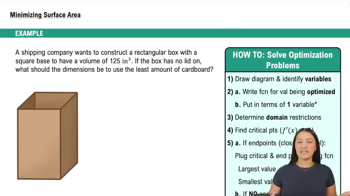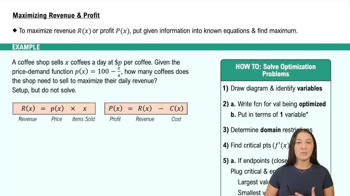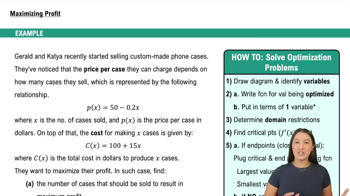Table of contents
- 0. Functions7h 52m
- Introduction to Functions16m
- Piecewise Functions10m
- Properties of Functions9m
- Common Functions1h 8m
- Transformations5m
- Combining Functions27m
- Exponent rules32m
- Exponential Functions28m
- Logarithmic Functions24m
- Properties of Logarithms34m
- Exponential & Logarithmic Equations35m
- Introduction to Trigonometric Functions38m
- Graphs of Trigonometric Functions44m
- Trigonometric Identities47m
- Inverse Trigonometric Functions48m
- 1. Limits and Continuity2h 2m
- 2. Intro to Derivatives1h 33m
- 3. Techniques of Differentiation3h 18m
- 4. Applications of Derivatives2h 38m
- 5. Graphical Applications of Derivatives6h 2m
- 6. Derivatives of Inverse, Exponential, & Logarithmic Functions2h 37m
- 7. Antiderivatives & Indefinite Integrals1h 26m
- 8. Definite Integrals4h 44m
- 9. Graphical Applications of Integrals2h 27m
- 10. Physics Applications of Integrals 2h 22m
5. Graphical Applications of Derivatives
Applied Optimization
Problem 4.5.42
Textbook Question
Light transmission A window consists of a rectangular pane of clear glass surmounted by a semicircular pane of tinted glass. The clear glass transmits twice as much light per unit of surface area as the tinted glass. Of all such windows with a fixed perimeter P, what are the dimensions of the window that transmits the most light?
 Verified step by step guidance
Verified step by step guidance1
Define the variables: Let the width of the rectangular pane be \( w \) and the height be \( h \). The radius of the semicircular pane is \( r \). The perimeter constraint is given by the equation \( 2h + 2w + \pi r = P \).
Express the area of the window: The area of the rectangular pane is \( A_{rect} = w \times h \) and the area of the semicircular pane is \( A_{semi} = \frac{1}{2} \pi r^2 \). The total area is \( A_{total} = wh + \frac{1}{2} \pi r^2 \).
Set up the light transmission function: Since the clear glass transmits twice as much light as the tinted glass, the light transmitted is \( L = 2wh + \frac{1}{2} \pi r^2 \).
Use the perimeter constraint to express one variable in terms of the others: Solve \( 2h + 2w + \pi r = P \) for one of the variables, for example, \( h = \frac{P - 2w - \pi r}{2} \). Substitute this into the light transmission function.
Optimize the light transmission function: Differentiate the light transmission function with respect to the remaining variables and set the derivatives to zero to find critical points. Use the second derivative test or other methods to determine which dimensions maximize the light transmission.
 Verified video answer for a similar problem:
Verified video answer for a similar problem:This video solution was recommended by our tutors as helpful for the problem above
Video duration:
5mPlay a video:
Was this helpful?
Key Concepts
Here are the essential concepts you must grasp in order to answer the question correctly.
Optimization
Optimization in calculus involves finding the maximum or minimum values of a function. In this context, we need to determine the dimensions of the window that maximize light transmission, which requires setting up a function that represents the total light transmitted and then using techniques such as derivatives to find critical points.
Recommended video:

Intro to Applied Optimization: Maximizing Area
Perimeter Constraint
The perimeter constraint is a fixed condition that limits the dimensions of the window. For this problem, the total perimeter of the rectangular and semicircular panes must equal a given value P, which introduces a relationship between the width and height of the window that must be considered when optimizing light transmission.
Recommended video:

Intro to Applied Optimization: Maximizing Area
Area and Light Transmission
The area of each pane of glass contributes to the total light transmitted, with the clear glass transmitting twice as much light per unit area as the tinted glass. Understanding how to calculate the areas of the rectangular and semicircular sections and their respective contributions to light transmission is crucial for formulating the optimization problem.
Recommended video:

Estimating the Area Under a Curve with Right Endpoints & Midpoint

 1:13m
1:13mWatch next
Master Intro to Applied Optimization: Maximizing Area with a bite sized video explanation from Callie
Start learningRelated Videos
Related Practice








